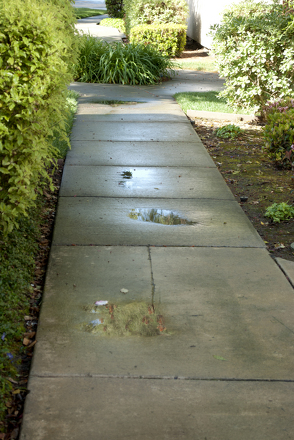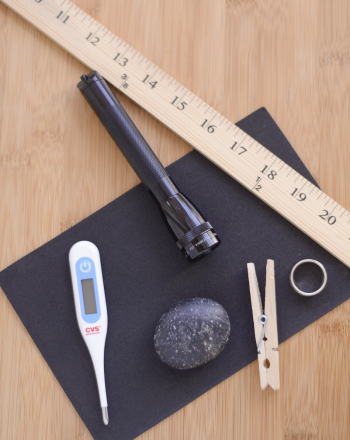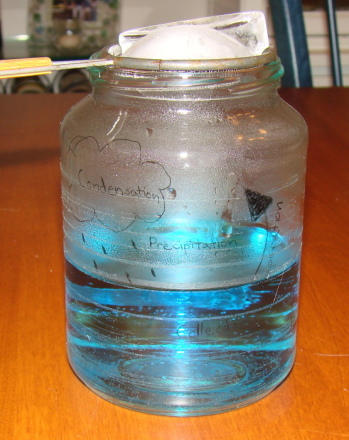Science project
Rate of Evaporation
Grade Level: 2nd - 5th; Type: Meteorology
Objective
The goal of this evaporation experiment is to learn about rate of evaporation and how different external conditions affect drying time.
Introduction
The speed water evaporates contributes directly to how much water vapor is in the air, and contributes indirectly to future precipitation. However, the rate of evaporation forms depends on external variables such as temperature, humidity and wind speed. Generally, when temperature and humidity are constant, and wind speed increases, the rate of evaporation increases as well. When temperature and wind speed are constant, but humidity increases, the rate of evaporation will decrease. When wind speed and humidity stay constant, and temperature increases, then the rate of evaporation will increase because warmer air can hold more water vapor than colder air. All of these variables work together so this experiment is really quite complex. Students include barometric pressure in their analysis because this tends to work in tandem with other variables.
Research Questions
- How does temperature affect the rate of evaporation?
- How does humidity affect the rate of evaporation?
- How does the wind affect the rate of evaporation?
- Is rising or falling barometric pressure associated with rapid evaporation? It is entirely possible that this effect is masked by other variables so do not worry if it is not apparent.
Materials
- Hand towel
- Clothes line
- Two clothespins
- Internet access
Terms to Know
- Temperature
- Humidity
- Independent variable
- Rate of evaporation
Experimental Procedure
- Create a 6-column data table. The column headings should be “date,” “drying time,” “humidity,” “temperature,” “wind,” and “barometric pressure.” Dampen the hand towel with 0.5 cup of water. The amount of water you use can be adjusted so that the volume of water is enough to make the towel wet, but not dripping. If you use less water, make a note indicating how much water you used.
- Hang your damp hand towel on a clothesline. Every 5-10 minutes, check to see how dry the towel has become. Once it has dried, calculate the total drying time.
- While the towel is drying, go to www.weather.com. Enter your zip code next to “Find Weather.” Click on “Expand Weather Details.” Record the temperature, barometric pressure, wind speed and humidity in your zip code. Windspeed should be entered on your data table as light (5 MPH or less), moderate (6 – 14 MPH) or strong (greater that 14 MPH).
- Repeat steps 1 – 3 every day for 2 – 3 weeks at the same time of day. Be sure to dry the towel on the same section of the clothesline so that the amount of direct sunlight on the towel does not vary.
- Evaluate your data as to how drying time relates to temperature, wind and humidity. This may not be easy to figure out because this variables are not independent. Once you think you have observed what is happening, check to see if it correlates with barometric pressure.
References:
- Williams, Jack, Rick Anthes and Stephanie Abrams. The AMS Weather Book: The Ultimate Guide to America's Weather. University of Chicago Press. (2009).
- Cox, John D. Weather for Dummies. For Dummies (2000).
- Water Evaporation Rate http://van.physics.illinois.edu/qa/listing.php?id=1440
- Rate of Evaporation
- http://www.theweatherprediction.com/habyhints2/470/
Education.com provides the Science Fair Project Ideas for informational purposes only. Education.com does not make any guarantee or representation regarding the Science Fair Project Ideas and is not responsible or liable for any loss or damage, directly or indirectly, caused by your use of such information. By accessing the Science Fair Project Ideas, you waive and renounce any claims against Education.com that arise thereof. In addition, your access to Education.com's website and Science Fair Project Ideas is covered by Education.com's Privacy Policy and site Terms of Use, which include limitations on Education.com's liability.
Warning is hereby given that not all Project Ideas are appropriate for all individuals or in all circumstances. Implementation of any Science Project Idea should be undertaken only in appropriate settings and with appropriate parental or other supervision. Reading and following the safety precautions of all materials used in a project is the sole responsibility of each individual. For further information, consult your state's handbook of Science Safety.













